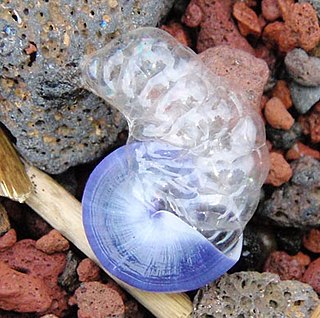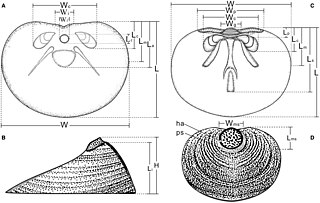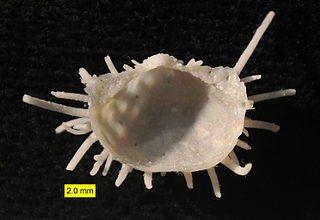
Ammonitida is an order of ammonoid cephalopods that lived from the Jurassic through Paleocene time periods, commonly with intricate ammonitic sutures.

Ensifera is a suborder of insects that includes the various types of crickets and their allies including: true crickets, camel crickets, bush crickets or katydids, grigs, weta and Cooloola monsters. This and the suborder Caelifera make up the order Orthoptera. Ensifera is believed to be a more ancient group than Caelifera, with its origins in the Carboniferous period, the split having occurred at the end of the Permian period. Unlike the Caelifera, the Ensifera contain numerous members that are partially carnivorous, feeding on other insects, as well as plants.

Rissooidea, originally named Rissoacea by Gray, 1847, is a taxonomic superfamily of small and minute marine snails, belonging to the clade Littorinimorpha.

The Lygaeoidea are a sizeable superfamily of true bugs, containing seed bugs and allies, in the order Hemiptera. There are about 16 families and more than 4,600 described species in Lygaeoidea, found worldwide. Most feed on seeds or sap, but a few are predators.

Orthida is an extinct order of brachiopods which appeared during the Early Cambrian period and became very diverse by the Ordovician, living in shallow-shelf seas. Orthids are the oldest member of the subphylum Rhynchonelliformea, and is the order from which all other brachiopods of this group stem. Physically they are usually strophic, with well-developed interareas. They also commonly have radiating ribs, sulcus, and fold structures. Typically one valve, often the brachial valve, is flatter than the other. The interior structure of the brachial valves are usually simple. In shape they are sub-circular to elliptical, with typically biconvex valves.

Cypraeoidea, the cowries and cowry allies, is a superfamily of sea snails, marine gastropods included in the clade Littorinimorpha. This superfamily had been called Cypraeacea and was named by Rafinesque in 1815.

CD81 molecule, also known as CD81, is a protein which in humans is encoded by the CD81 gene. It is also known as 26 kDa cell surface protein, TAPA-1, and Tetraspanin-28 (Tspan-28).

The Ptenoglossa is an informal taxonomic group of sea snails. This group was considered paraphyletic or polyphyletic by Ponder and Lindberg (1997) in their classification of gastropod molluscs.

Acrotretides (Acrotretida) are an extinct order of linguliform brachiopods in the class Lingulata. Acrotretida contains 8 families within the sole superfamily Acrotretoidea. They lived from the Lower Cambrian to the Middle Devonian, rapidly diversifying during the middle Cambrian. In the upper Cambrian, linguliforms reached the apex of their diversity: acrotretides and their relatives the lingulides together comprised nearly 70% of brachiopod genera at this time. Though acrotretides continued to diversify during the Ordovician, their proportional dominance declined, as rhynchonelliforms took on a larger role in brachiopod faunas.
Yukoniidae S. Zhang, 1980 [nom. transl. et emend. Jell, in Whittington et al., 1997 ex Yukoniinae S. Zhang in W. Zhang, Lu et al., 1980] is a small family of trilobites, belonging to the Eodiscina.

Productida is an extinct order of brachiopods in the extinct class Strophomenata. Members of Productida first appeared during the Silurian. They represented the most abundant group of brachiopods during the Permian period, accounting for 45-70% of all species. The vast majority of species went extinct during the Permian-Triassic extinction event, though a handful survived into the Early Triassic. Many productids are covered in hollow tubular spines, which are characteristic of the group. A number of functions for the spines have been proposed, including as a defensive mechanism against predators.
Strophomenoidea is an extinct superfamily of prehistoric brachiopods in the order Strophomenida.
An order of brachiopods containing the families:
Protorthida is an extinct order of Rhynchonellate brachiopods containing the taxa:
Enteletoidea is an extinct superfamily of brachiopods in the order Orthida, containing:
A superfamily of brachiopods containing:
Orthoidea is a superfamily of brachiopods containing the families:
A superfamily of brachiopods containing:
Lyttoniidina is a suborder of the brachiopod order Productida containing the families:
Strophalosiidina is a suborder of Brachiopod containing the families:









